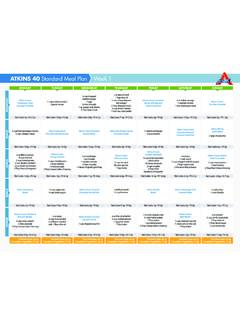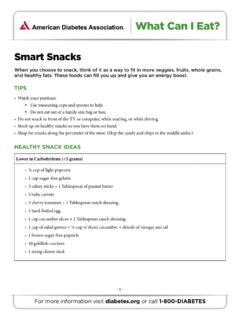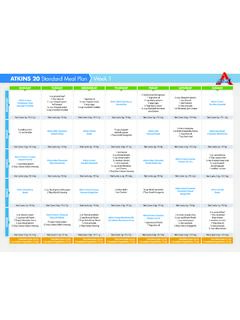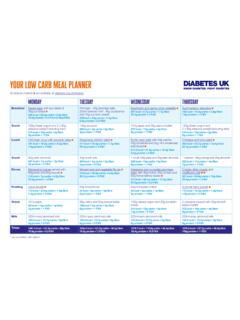Transcription of nutrition GUIDE - U.S. Anti-Doping Agency (USADA)
1 1 nutritionGUIDEFUELING FOR PERFORMANCE1 B This nutrition GUIDE provides general guidelines to help optimize dietary intake for sports competitors. Fueling requirements can vary depending upon an individual s energy expenditure, metabolism, state of health, sport, etc. Now more than ever, athletes need accurate sports nutrition information. Optimal nutrition is an integral part of peak performance while an inadequate diet and lack of fuel can limit an athlete s potential for maximum performance. Unfortunately, there is a lot of misinformation available regarding a proper diet for athletes. In the quest for success, many athletes will try any dietary regimen or nutritional supplementation promising a new level of physical performance.
2 However, an evaluation and modification of current dietary intake can typically be employed to help maximize peak human body must be supplied with energy to perform its many complex functions. As an athlete s training and competition level increases, the body s energy demands also increase. Several energy systems in the body can provide athletes with fuel as long as they are consuming the proper foods. One energy system relies totally on carbohydrates while another uses carbohydrates as well as fats. When an athlete works near or at maximal intensities, carbohydrates are the prime fuel the body can use. During prolonged exercise, such as cycling, triathlons, and long-distance swimming, the amount of fats and carbohydrates used may rise and fall depending upon.
3 F Duration and intensity of the exerciseF An individual s fitness level F Food and drink consumed prior to and during the exerciseTHE PURPOSE OF THIS BOOK contentsCarbohydrates The Master Fuel page 2 Protein s Role as a Team Player page 12 Building Body Mass page 14 Fat as Fuel page 16 Gut Health page 17 Vitamins and Minerals page 18 Supplements and Your Health page 21 Fluids and Hydration page 24 Bottom Line page 283 2 Carbohydrates The Master FuelA diet rich in carbohydrates increases both endurance and intermittent high-intensity performance because of the extra store of carbohydrates in the muscles and liver, called glycogen. It is well documented that athletes need to replenish carbohydrate stores in the body, especially during periods of intense training or competition.
4 Consuming carbohydrates during workouts lasting more than one hour can also benefit performance and delay onset of fatigue. Studies have shown that athletes who participate in intermittent sports, such as basketball and soccer, should also focus on consuming more carbohydrates during training and competition. This is not surprising since it is well-known that carbohydrates, when compared to protein and dietary fat, are the most efficiently broken down and metabolized form of energy for the body. Recommended Intake of Carbohydrates Depending upon the training routine, athletes should consume anywhere from 3-12 grams of carbohydrates per kilogram of bodyweight throughout the day. This percentage is only a guideline for estimating carbohydrate needs.
5 Depending upon the length and type of training sessions, an athlete s carbohydrate intake should adjust, with longer times and more intense trainings reflecting the higher number of grams needed. See Table 1 to calculate grams of carbohydrates Intake Before, During, and After ExerciseBefore Exercise: The pre-exercise or pre-training meal serves two purposes:F It keeps the athlete from feeling hungry before and during It maintains optimal levels of energy for the exercising who train early in the morning, before eating or drinking, should ensure the previous night s meal contains adequate carbohydrates and then consume about 30 grams of well tolerated carbohydrates 5 minutes prior to training to help maintain blood glucose and muscle glycogen levels.
6 Blood glucose, the sugar found in the blood, is the energy delivered to the working muscles and organs, along with muscle glycogen, that allows your body to complete Table 1 to calculate grams of carbohydrates needed. DETERMINING GRAMS OF CARBOHYDRATE FOR ATHLETES NEEDSThe following example shows how to calculate the recommended grams of carbohydrate needed per pound of body weight. Weight in Kilograms Carbohydrates in Grams Daily Carbohydrate Intake 68 (150 lbs.) x 4 = 272 gramsNow calculate your own needs. Remember to divide your body weight in pounds by to get your weight in kilograms. Then multiply your body weight by a number of carbohydrate grams (from the 3-12 range) based on the time and intensity of the training. For example, an hour per day of moderate intensity exercise may warrant using 5 grams.
7 Weight in Kilograms Carbohydrates in Grams Daily Carbohydrate Intake x = Table 1: AS EARLY AS THE 1930S, SCIENTISTS OBSERVED THAT ENDURANCE EXERCISE COULD BE IMPROVED BY INCREASING CARBOHYDRATES IN THE DIET. FYI (focus on your intake) 5 4 Carbohydrate intake before and after exercise can help to restore sub-optimal glycogen stores, which is critical for prolonged periods of exercise. While allowing for personal preferences and physiological factors, the pre-event meal should be high in carbohydrates, non-greasy, and readily digestible. Fatty foods should be limited as they delay the emptying time of the stomach and take longer to digest. The following are guidelines for the pre-event meal:F The meal should be eaten 3-4 hours before an It should provide 3-4 grams per kilogram of body To avoid stomach upset, the carbohydrate content of meals should be reduced the closer the meals are to the event (1-2 grams per kilogram 1-2 hours before the event).
8 F Adding small amounts of protein can aid in regulating energy levels by slowing down carbohydrate absorption, delivering the carbohydrates to the working muscles at a more consistent rate over Pay attention to salty cravings. If competing in hot/humid climates, make sure to replace electrolyte losses with salty snack foods, such as pretzels or sport drinks with added sodium.[For example, four hours before the event, it is suggested that the athlete consume grams of carbohydrates per pound of body weight, whereas one hour before the competition, the athlete would consume grams of carbohydrates per pound of body weight.]*Remember that sports drinks are beverages that contain electrolytes and carbohydrates, not caffeine and other stimulants.
9 For more information on sports drinks and hydration, read the Fluids and Hydration section. SUGGESTED MEALS FOR PRE-EVENT EATINGThis example shows how to calculate the recommended grams of carbohydrate needed per pound of body weight. 1 hour or less Serving size Grams of carbohydrates Dried mango 3 oz 28 g Raisins small box ( oz) 34 g Banana 7 oz 31 g Granola bar 2 bar pack 29 g Pretzels 20 pieces 22 g Fig bar (2) 1 oz 20 g Applesauce 4 oz 14 g Sports drink* 8 oz 14 g Toast 1 slice 14 g Crackers 5 crackers 10 gTable 2: SUGGESTED MEALS FOR PRE-EVENT EATING (continued) 2-3 hours before Serving size Grams of carbohydrates Baked potato (plain) 1 large 58 g Cereal (whole grain)/ cereal: 1 cup cereal: 47 g low-fat milk (1%) milk: 1/2 cup milk: 8 g Bagel (whole grain) 1 bagel bagel: 47 g with peanut butter 2 tbsp peanut butter peanut butter.
10 8 g Fruit smoothie 12 fl oz 47 g Food bar 1 bar 43 g (oatmeal raisin walnut) Oatmeal (instant)/ oatmeal: 1 cup oatmeal: 26 g low-fat milk (1%) milk: 1/2 cup milk: 8 g Flavored Greek yogurt (nonfat) 1 cup 27 g Pancakes/waffles 2 pancakes 20 g (from mix) (5 diameter) Fresh fruit (chopped apple) 1 cup 19 g 4 or more hours before Serving size Grams of carbohydrates Spaghetti with meat sauce 2-3 cups 75-100 g Pasta/ pasta: 1 cup pasta: 60 g Chicken/ chicken: 4 oz chicken: 0 g Vegetables vegetables: 1 cup vegetables: 6 g Grilled chicken/ chicken: 3 oz chicken: 0 g rice (white)/ rice: 6 oz rice: g fruit (grapes) fruit: 1 cup fruit: 25 g Snack bar 1 bar bar: 43 g (oatmeal raisin walnut)/ sports drink* drink: 8 oz drink: 14 g High protein milk shake 12 fl oz 40 g Turkey sandwich turkey: 1 slice turkey: 0 g (w/3 slices deli meat, mayo: 1 tbsp mayo: 0 g 2 slices whole wheat bread, bread: 2 slices bread: 12 g low-fat mayo)/baby carrots 7 carrots carrots: 3 g Tuna sandwich tuna: 2 oz drained tuna: 0 g (2 slices whole wheat bread)/ bread: 2 slices bread: 24 g nonfat mayo mayo: 1 tbsp mayo: 0 g Trail mix with nuts/raisins 1/3 cup 20 g7 6 Eating At All-Day Events: It is important that athletes eat after competing to make sure that they will have enough energy in the muscles for the next race or competition, whether it be in the same day or the following days.






